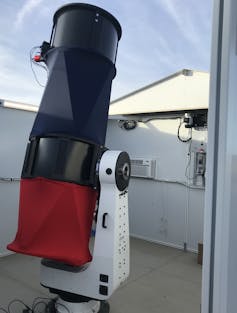JOHN MURILLO
Extremely rare half female, half male Green Honeycreeper spotted by an Otago professor in rural Columbia.
It’s only the second such sighting in more than 100 years; a half-male, half-female bird.
Kiwi professor Hamish Spencer was holidaying in Colombia when his fellow bird watcher pointed to a distinct half green and half blue bird. He knew it was the most “unusual bird sighting in his life.”
Spencer, a Sesquicentennial Distinguished Professor in University of Otago’s Department of Zoology, was holidaying in rural Manizales of Colombia in January, when amateur ornithologist John Murillo pointed out wild Green Honeycreeper.
“It was a wow moment. It is a common bird in Columbia, but this
The sighting was only the second recorded example of gynandromorphism [an organism that contains both male and female characteristics] in the species in more than 100 years.
Spencer said what made the bird unusual was that it exhibited typical male plumage on its right side and female plumage on the left.
A rare phenomenon called Bilateral Gynandromorphy is a condition in which one side of an animal/bird exhibits male characters and the other female.

JOHN MURRILO/SUPPLIED
The striking Green Honeycreeper has half green and half blue plumage – an extremely rare phenomenon in birds.
“Many birdwatchers could go their whole lives and not see a bilateral gynandromorph [an animal half him and half her] in any species of bird.
“The phenomenon is extremely rare in birds, I know of no examples from New Zealand ever.”
“I don’t expect to see one again in my life.”
Photographs of the bird make the discovery even more significant as they are “arguably the best of a wild bilateral gynandromorphic bird of any species ever”.
Professor Spencer explained gynandromorphs – animals with both male and female characteristics in a species that usually have separate sexes – were important for understanding of sex determination and sexual behaviour in birds.

JOHN MURRILO/SUPPLIED
Professor Hamish Spencer’s report on the find, only the second recorded example of gynandromorphism in the species in more than 100 years, has been published in the Journal of Field Ornithology.
He hoped the novel discovery would inspire people to “treasure exceptions” as they always revealed something interesting.
“Be always on the lookout for oddities – who will find the first New Zealand example of a bilateral gynandromorph in a bird?”
The finding was published in the Journal of Field Ornithology last Friday.
Extremely rare bird captured on film
IMAGE:
PHOTOS OF A BILATERALLY GYNANDROMORPHIC GREEN HONEYCREEPER NEAR MANIZALES, COLOMBIA, 20 MAY 2022. CREDIT: JOHN MURILLO
view moreCREDIT: CREDIT: JOHN MURILLO
A striking and extremely rare half female, half male bird has been spotted by a University of Otago zoologist.
Sesquicentennial Distinguished Professor Hamish Spencer was holidaying in Colombia when an amateur ornithologist John Murillo pointed out a wild Green Honeycreeper with distinct half green, or female, and half blue, male, plumage.
“Many birdwatchers could go their whole lives and not see a bilateral gynandromorph in any species of bird. The phenomenon is extremely rare in birds, I know of no examples from New Zealand ever.
“It is very striking, I was very privileged to see it,” Professor Spencer says.
Photographs of the bird make the discovery even more significant as they are “arguably the best of a wild bilateral gynandromorphic bird of any species ever”.
A report on the find, only the second recorded example of gynandromorphism in the species in more than 100 years, has just been published in the Journal of Field Ornithology.
Professor Spencer says gynandromorphs – animals with both male and female characteristics in a species that usually have separate sexes – are important for our understanding of sex determination and sexual behaviour in birds.
The main groups in which the phenomenon has been recorded include animal species which feature strong sexual dimorphism; most often insects, especially butterflies, crustaceans, spiders, even lizards and rodents.
“This particular example of bilateral gynandromorphy – male one side and female the other – shows that, as in several other species, either side of the bird can be male or female.
“The phenomenon arises from an error during female cell division to produce an egg, followed by double-fertilization by two sperm,” he explains.
He hopes the novel discovery will inspire people to “treasure exceptions” as they always reveal something interesting.
“Be always on the lookout for oddities – who will find the first New Zealand example of a bilateral gynandromorph in a bird?”
ARTICLE TITLE
Report of bilateral gynandromorphy in a Green Honeycreeper (Chlorophanes spiza) from Colombia
Joanna (z-lib.org).pdf
(PDF) Joanna Russ: The Female Man | Jeanne Cortiel
(PDF) Joanna Russ's The Female Man: Science Fiction ...
(PDF) Joanna Russ's The Female Man: A Butlerian Approach
Daily singing workout keeps songbird males attractive
Peer-Reviewed PublicationEvery year in the Christmas season it becomes clear again that some people are amazingly skilled singers, like Mariah Carey and George Michael. Their singing can stir strong emotions.
Singing involves probably the most complex, and mostly hidden, movements humans and animal can make. To become a good singer, you need to learn how to coordinate the movements of hundreds of muscles in your body with extreme precision. Therefore, you need a lot of talent, and practice.
We all know that athletes invest a lot of time exercising their limb and body muscles, but how about training the muscles in your voice box?
“Surprisingly we know very little about effects of exercise on these muscles and if they even react to training in humans,” says Professor Coen Elemans from the University of Southern Denmark, expert on sound production, “No singer will let you come even near their precious voice box”.
Now a new study in the prestigious journal Nature Communications reports that male songbirds need to sing daily to exercise their vocal muscles and produce pretty songs. And the females notice if they didn’t.
“Singing is crucial for songbirds. They sing to impress future partners, to defend their territories and to maintain social bonds,” says Dr. Iris Adam, lead author of the study.
The researchers show that training is necessary to keep songbird vocal muscles at top performance. And it is not just any training, it specifically is singing exercise that matters.
The study was conducted by an international team of researchers from the University of Southern Denmark, Leiden University, University of Umea and the University of Vermont and was led by Assistant Professor Iris Adam and Professor Coen Elemans at the Department of Biology University of Southern Denmark.
Vocal muscles need exercise, too
“It has long been known that songbird singing is controlled by fast vocal muscles, but until now we only had very little knowledge if and how these muscles might respond to exercise, like our leg muscles do”, says Iris Adam.
In their study, the researchers show that if songbirds don’t use their vocal muscles at all, they get much slower and weaker already within days. But even when the birds only skip singing, after 7 days the vocal muscles already lost 50% of their strength.
“This was very surprising”, says Dr. Adam, “First that these muscles reacted so strongly, but also how incredibly fast they lost performance. Indeed, it’s use it or lose it!”
Partners can hear the difference
When analyzing the songs sung, the team found that the birds sang differently before and after exercise.
“You and I could barely hear a difference between the songs, but we saw clear effects when we analyzed our song recordings”, says Dr. Adam.
As the ultimate test if this difference was important to the birds, the team next played songs to female zebra finches to ask them if they could hear a difference between before or after exercise, and which song they liked more.
"The female zebra finches in the playback experiment could directly hear the difference and 75 percent preferred the songs from the well exercised male", says Katharina Riebel, author on the study and expert in animal behaviour.
The daily dawn chorus, an alternative explanation
“Interestingly, these results provide an alternative reason why birds sing so much and every day”, says Elemans.
Around the world, in spring and summer time, birds sing every morning in the daily dawn chorus. Why they do this is still puzzling to scientists.
“A lot of that singing seems out of context. They sing when they don’t need to,” says Adam.
“Our results now show that if they don’t exercise every day, their muscle performance decreases”, says Elemans, “On top of that, the lack of exercise is audible in their song and the females prefer song from exercised males”.
Thus, songbirds may need to invest lots of time and energy in singing every day to remain attractive.
And this may be true for all animals.
Vocal muscles need training programs different from leg muscles
When studying the zebra finch vocal muscles, the team made another very important discovery.
“When we humans go to the gym to exercise leg and arm muscles, they typically get slower with exercise,” says Per Stål, author on the study and expert in muscle exercise physiology in humans.
However, in songbirds vocal muscles don’t get stronger and slower with exercise, like limb muscles, but weaker and faster. This is opposite from normal limb and body muscles.
“This reversed training may be a unique feature for vocal muscles, that we think might be true for all vertebrates, including humans, because all vocal muscles are developmentally related”, says Iris Adam.
“Therefore, these findings can have major consequences for speech therapy and vocal training in humans”, says Coen Elemans.
Because it’s so challenging to study the physiology of human larynx muscles, therapeutic intervention is based on what we know from exercise physiology of leg muscles.
“However, training vocal muscle may thus work very differently”, says Elemans, adding that “Songbirds may be our best allies to study the physiology of vocal muscle to further improve voice training and rehabilitation in humans”.
JOURNAL
Nature Communications
METHOD OF RESEARCH
Experimental study
SUBJECT OF RESEARCH
Animals
ARTICLE TITLE
n/a








